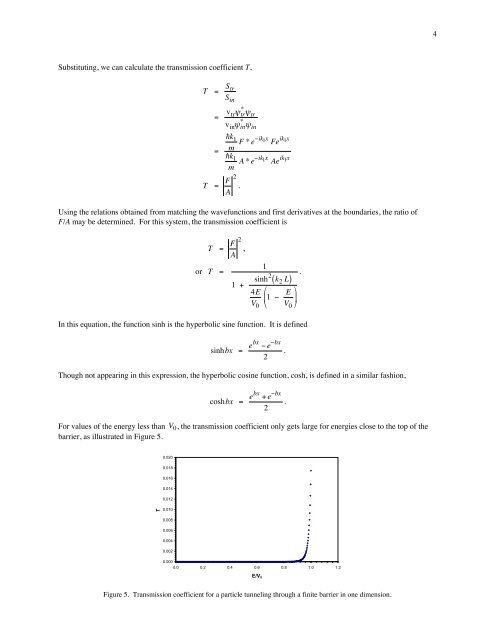Tunneling
Tunneling
Tunneling
You also want an ePaper? Increase the reach of your titles
YUMPU automatically turns print PDFs into web optimized ePapers that Google loves.
4<br />
Substituting, we can calculate the transmission coefficient T,<br />
T = S tr<br />
S in<br />
= v trψ * tr ψ tr<br />
v in ψ * in ψ in<br />
=<br />
T = F A<br />
k 1<br />
m F * e−ik 1x Fe<br />
ik 1 x<br />
k 1<br />
m A * e−ik 1 x Ae ik 1 x<br />
2<br />
.<br />
Using the relations obtained from matching the wavefunctions and first derivatives at the boundaries, the ratio of<br />
F/A may be determined. For this system, the transmission coefficient is<br />
€<br />
T = F A<br />
2<br />
,<br />
or T =<br />
1 +<br />
1<br />
sinh 2 .<br />
( k 2 L)<br />
4E ⎛⎛<br />
1 − E ⎞⎞<br />
⎜⎜ ⎟⎟<br />
V 0 ⎝⎝ V 0 ⎠⎠<br />
In this equation, the function sinh is the hyperbolic sine function. It is defined<br />
€<br />
sinhbx = ebx − e −bx<br />
.<br />
2<br />
Though not appearing in this expression, the hyperbolic cosine function, cosh, is defined in a similar fashion,<br />
€<br />
coshbx = ebx + e −bx<br />
.<br />
2<br />
For values of the energy less than V 0 , the transmission coefficient only gets large for energies close to the top of the<br />
barrier, as illustrated in Figure 5.<br />
€<br />
€<br />
0.020<br />
0.018<br />
T<br />
0.016<br />
0.014<br />
0.012<br />
0.010<br />
0.008<br />
0.006<br />
0.004<br />
0.002<br />
0.000<br />
0.0 0.2 0.4 0.6 0.8 1.0 1.2<br />
E/V 0<br />
Figure 5. Transmission coefficient for a particle tunneling through a finite barrier in one dimension.

















